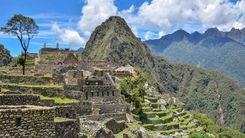The ruins
Entering the ruins, after passing the restored sectors, which include the Templo de la Luna (Temple of the Moon) and the Convento de las Virgenes del Sol (Convent of the Sun Virgins, or Mamaconas), you can see the later Inca construction of the Sun Temple directly ahead. Constructed on the top level of a series of pyramidical platforms, it was built tightly onto the hill with plastered adobe bricks, its walls originally painted in gloriously bright colours. From the very top of the Sun Temple there’s a magnificent view west beyond the Panamerican Highway to the beach (Playa San Pedro) and across the sea to a sizeable yet uninhabited island, which resembles like a huge whale approaching the shore. Below the Sun Temple is the main plaza, once covered with a thatched roof supported on stilts, and thought to have been the area where pilgrims assembled in adoration. The rest of the ruins, visible though barely distinguishable, were once dwellings, storehouses and palaces.
Idols and oracles
Pachacamac means (more or less) “Earth’s Creator”, and the site was certainly occupied by 500 AD and probably for a long time before that. When other huacas were being constructed in the lower Rimac Valley, Pachacamac was already a temple-citadel and centre for mass pilgrimages. The god-image of Pachacamac was believed to express his or her anger through tremors and earthquakes, and was an oracle used for important matters affecting the State: the health of the ruler, the outcome of a war and so on. Later this became one of the most famous shrines in the Inca Empire, with Pachacamac himself worshipped along with the sun. The Incas built their Sun Temple on the crest of the hill above Pachacamac’s own sacred precinct.
In 1533, Francisco Pizarro sent his brother Hernando to seize Pachacamac’s treasure, but was disappointed by the spoils, which consisted of little more than a wooden idol representing, through intricate carvings, a two-faced humanoid. This wooden representation of Pachacamac may well have been the oracle itself: it was kept hidden inside a labyrinth and behind guarded doors – only the high priests could communicate with it face to face. When Hernando Pizarro and his troops arrived they had to pass through many doors to arrive at the main idol site, which was raised up on a “snail-shaped” (or spiralling) platform, with the wooden carving stuck into the earth inside a dark room, separated from the world by a jewelled curtain. Pizarro ended up burning the complex to the ground, dissatisfied with the relatively small amounts of gold on offer.
As well as earthquakes, Pachacamac’s powers extended to the absence or presence of disease and pestilence. His wife, or female counterpart, was believed to dominate plant and fish life.



